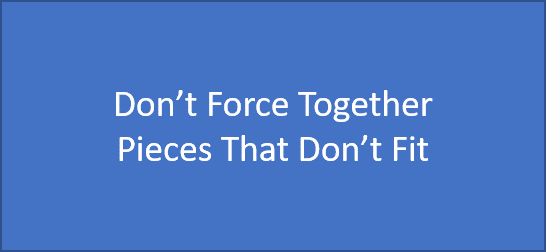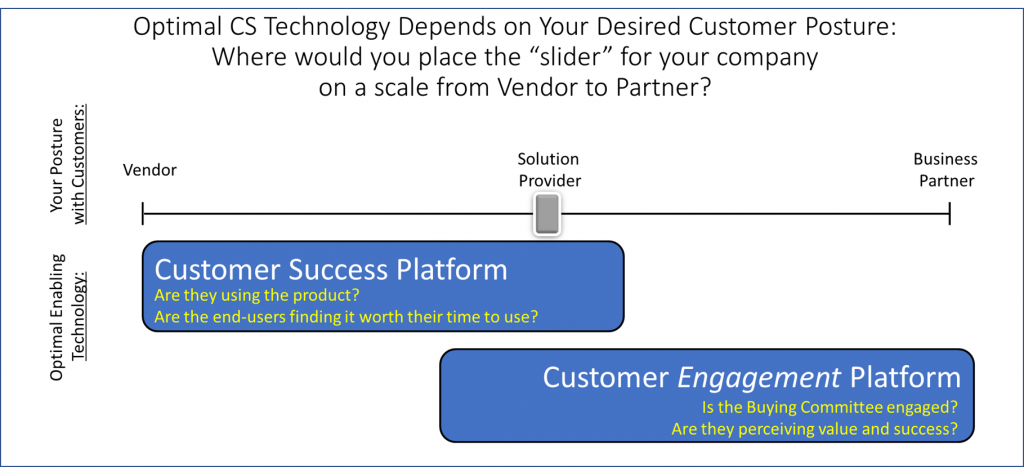Search Waypoint Resources
Customer Success Technology Selection Depends on Whether You’re Dating or Getting Married

We are often asked about various technologies that best support a Customer Success (CS) team. We’ve found that there are 2 general approaches to CS technology, and selecting the right approach generally depends on the complexity of the products and services your company provides. The key question is, what is your company’s “posture” when selling into new companies?
1. Are you “dating” your customers? Are you providing products and services into a mature market that knows how to make it work? Is switching “easy” and generally controlled by end-users?
- If you’re providing a stand-alone product, probably with lower cost and lower complexity and one that generally doesn’t require “administration” or integration, then a solution that allows you to easily monitor utilization and adoption is key. The end-users in this category probably make the decision regarding if / how / when they use it, and they care about how the tool helps them personally.
- In other words, the end-users in this category hold the power with regards to whether they use the product, and your primary concern as a Customer Success practitioner is whether the product is easy to use and helps end-users get things done more productively and/or with higher quality than other methods. The right CS technology here monitors product utilization and helps you spot declining usage that might indicate competitive incursion (i.e. declining wallet share). If an end user stops using the product, then outreach from the CSM to remediate would be ideal. You probably want to consider Customer Success Platform products such as Gainsight, Client Success, etc.
2. Or are you getting married? Is there business process-integration that is required to truly achieve the promised outcomes? Do you provide best-practices to help customers acquire the value? Are you selling a complex product that requires “organizational change” principles to acquire results? Does your product allow for many use cases that need to be configured?
- If your offerings are part of a larger set of business processes and require integration with other systems and/or processes in order to genuinely acquire the value then there’s undoubtedly a “buying committee” (whether formal or informal) that is making the purchase and renewal decisions. Here, monitoring utilization is *not* sufficient. You will need a solution that keeps your key Buying Committee members engaged, helps you strengthen relationships, provides clarity around their perception of value, and that shows you if your offerings are driving the promised business outcomes (measurable results).
- In other words, the Buying Committee holds the power with regards to whether the end-users use the product. While “ease of use” is certainly a concern, your first-order mission is to make sure the business processes are defined, that the Buying Committee (decision makers and influencers, who probably aren’t directly interacting with your product) are engaged to drive the necessary organizational change, that they see value and success, and that you are helping your customers through the “change.” A solution that keeps your Buying Committee engaged and on the right track is key. In this area, you will want to consider Engagement solutions such as TopBox, Kapta, or perhaps Medallia for B2B to complement your Salesforce-based infrastructure.

When looking for support CS technology, the key is to align with your company’s “posture” when selling into new companies: Do your company’s Sales and Marketing efforts communicate that you supply products? Or, do you provide outcomes?
Customer Success is not a “one-size-fits all” – there are different CS processes for different types of markets and products – and selecting the right approach is critical if you want to manage retention and accelerate expansion. For example, does your company sell to both enterprise (complex) accounts, and also to small businesses? Selling into the Enterprise market is generally more complex and generally a relationship sale, but not necessarily so… are your offerings part of an integrated process, or more of a stand-alone tool? Does the business sell to an audience (perhaps by geography or use-case) that is more ready/mature, or is it just getting started? You may find that serving multiple markets requires multiple approaches with differing technology (automation/scalability) requirements.
We often find providers saying that they want their customers to think of them as ‘partners’ and not just vendors. But “partnership” (by definition) is a 2-way street: You can’t expect customers to consider you to be a partner if you’re not also demonstrating partnership. As a result, most companies have a mix of different customer types – and therefore have a mix of supporting technologies – and generally place customers into differing tiers (e.g. Tier 1 / 2 / 3, or high-touch / mid-touch / tech-touch) to establish the level of investment to make in how customers are served. If you’ve not established your customer-tiering strategy and definition then you’ll want to start here before selecting any technology.
Bottomline: Before you select a technology platform, be sure you understand your customer engagement strategy FIRST, followed by the processes you want to embed and automate with the technology. Once you have a clear approach nailed down, selecting the right types of tools and providers should be an easier process.